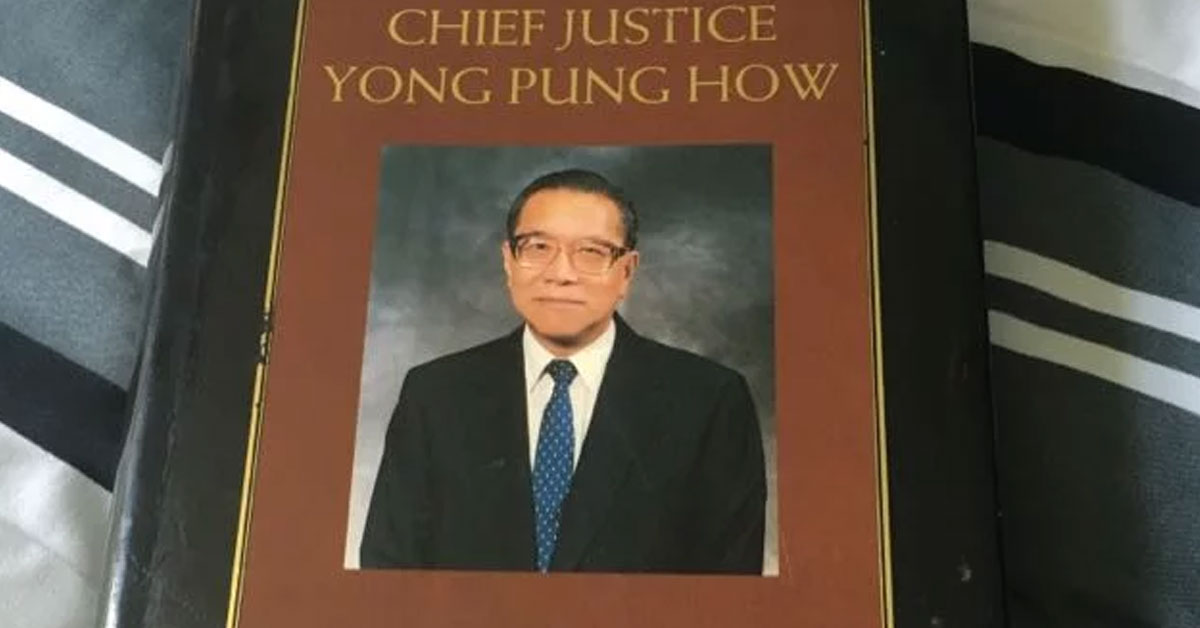Unless you’re from SMU or you study law, you probably didn’t know who Yong Pung How is.
The Chancellor of SMU, who’s more known as the second Chief Justice of Singapore, passed away today (9 Jan 2020) at the age of 93.
So, who is Yong Pung How and what are his contributions to Singapore?
Here are ten facts you probably should know.
Singapore’s Second Chief Justice
Before anything, you need to know what a Chief Justice is.
To simplify things, just understand this: to run a country, there should be three different “departments”:
- The department that makes the laws
- The department that ensures people obey the laws
- The department that decides whether the law is obeyed or not.
In Singapore, the Parliament makes the laws, the cabinet make sure people obey the laws and the justice department interprets the laws.
So, the head of government is the Prime Minister, and the head of the justice department is the Chief Justice.
In other words, a Chief Justice isn’t a politician per se, but a position recommended by the Prime Minister and appointed by the President.
His role is, of course, to head the supreme court.
Yong Pung How is the second Chief Justice of Singapore; the first is Wee Chong Jin, who was in office from 1963 to 1990.
Yong Pung How served as the Chief Justice for 26 years, from 1990 to 2006.
The current Chief Justice is Sundaresh Menon.
Born in KL, Malaya
Notice how I used the word “Malaya” instead of “Malaysia”?
Because back in 1926, when Yong was born, there was no Singapore or Malaysia; we were all part of the British.
Yong was born on 11 April 1926. His father was also a lawyer.
Young Yong then studied in Victoria Institution and then went to England to read law in Cambridge University, whereby he made friends with the founding father of Singapore, Lee Kuan Yew.
He went back to Malaya to practise law as a partner in his father’s law firm.
Two years later, he made his way to Singapore after the then Governor of Singapore, Sir John Fearns Nicoll (yes, Nicoll Highway is named after him), sought his help to resolve a dispute between the Singapore government and the general clerical services and telecommunications workers.
Worked with Lee Kuan Yew Before
Yong wasn’t just friend friend with Lee Kuan Yew in England; after they graduated, he worked with Lee on a few cases together.
In fact, they were so close that whenever Yong came to Singapore from KL, he would meet up with Lee and stayed in his house.
Now, remember this fact because it’s going to be relevant later.
Became a Banker in 1971
The lawyer didn’t just practise law: he was also the Chairman of the then Malaysia-Singapore Airlines and the Deputy Chairman of Maybank.
And soon, in 1971, the high-flyer switched career to head companies: he was the Chairman and Managing Director of Singapore International Merchant Bankers Limited (SIMBL) and the Malaysian International Merchant Bankers (MIMB) in Malaysia, and also the Vice-Chairman of OCBC.
With his experience in both laws and finance, you can bet that the Government’s going to headhunt him.
And headhunt they did.
Formed Government of Singapore Investment Corporation (GIC) and the Monetary Authority of Singapore (MAS)
GIC and MAS might be household names to us, but I bet you didn’t know that Yong was the person who formed the organizations and headed them in the initial years.
Advertisements
He went back to the private sector a year later, but returned to the public sector in 1989 as a judge.
How He Became a Chief Justice
In the year that he became a judge, Lee Kuan Yew told Yong that Singapore was looking for a new Chief Justice and Yong was one of the candidates. Lee then told Yong to “think about it”, but told him to make a decision quickly.
Yong then replied, “Can I think about it?”
That was when Lee Kuan Yew became the Lee Kuan Yew we’ve come to love: he scolded Yong, saying, “That was what I said. But I hope your answer will be yes because you have done nothing for Singapore!”
When Yong asked about his job scope, Lee retorted, “Become Chief Justice! Just clean up the whole thing, you know what to do.”
Advertisements
Oh, how much we miss you, Mr Lee.
Lee Kuan Yew’s Tactic
Apparently, Yong had asked Lee that “if the job is too much for me, will you release me?”
Lee didn’t reply, and on the next day, Yong’s name was in the papers and he became Singapore’s second Chief Justice. And let’s just say that he didn’t need to be “released”: he was in the seat for a whopping 26 years.
And he really cleaned up the whole thing.
Pay Cut from $2 million a Year to Less Than $300,000
You’ve got to hand it to Lee Kuan Yew; he can really sell ice to Eskimos.
According to Mothership.sg, his transition to be a Chief Justice means that he’d have a take a paycut: from $2 million a year to less than $300,000 a year.
But of course, thank God he did that because…
Turn Singapore Court into a Singapore Court
What’s Singapore most known for?
Advertisements
Our efficiency.
Before Yong took over, the courts had a massive backlogs: over 2,000 cases.
If Amos Yee were still in Singapore and Chief Justice Yong hadn’t taken over, he most probably is still waiting for his trial here in Singapore.
Yong revamped the system, bringing in technology and reducing paperwork so that cases can be cleared faster. In fact, he even made lawyers pay $10 per page if their documents are more than 150 pages, so lawyers can’t be long-winded while attending court.
And because of that, 25,000 cases were cleared when Yong was the Chief Justice: it was so effective that in 2001, 10% of the court time was unused—a first in Singapore.
Night Court is His Idea
If you’ve been summoned to court before and saw that it’s after office hours, you’d think that it could be a scam.
Apparently not.
Yong was the one who think that members of public shouldn’t need to take time off work for minor offences, and therefore implemented the night courts.
Universities Gave Him Doctorates Like Water
For his contribution to Singapore, Yong has been awarded two honourary doctorates: one from the National University of Singapore Faculty of Law and the other from Singapore Management University (SMU).
In 2007, he was also appointed as the chairman of the SMU School of Law’s advisory board, and in 2010, he was appointed Chancellor of SMU.




